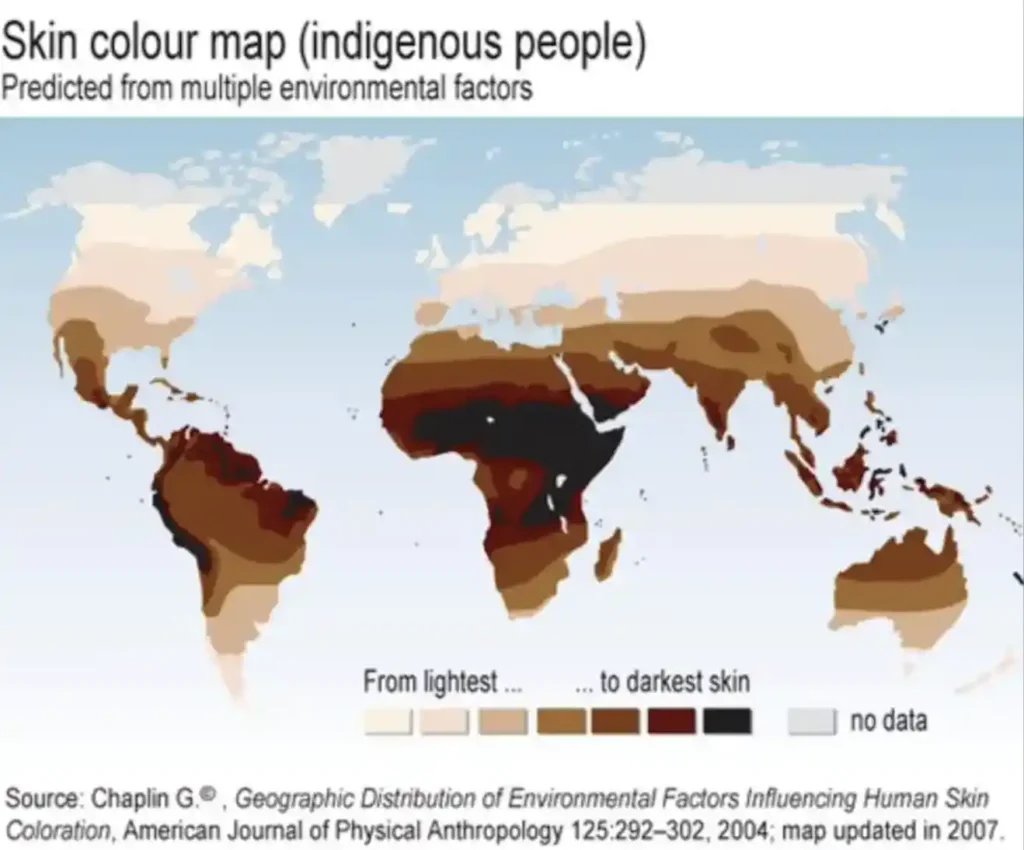Introduction of Normal Skin Colour:
Understanding normal skin colour is essential for appreciating the beauty of diversity and promoting skin health. This article delves into the various factors that contribute to normal skin colour, focusing on the intricate role of melanin and its production.
I. Melanin and Skin Pigmentation:


Melanin, the pigment responsible for skin colour, plays a crucial role in determining individual variations in complexion. Melanocytes, specialised cells in the skin, produce melanin, which is then distributed to surrounding skin cells.
A. Definition and Function of Melanin:
Melanin is a complex polymer derived from the amino acid tyrosine. It serves as a natural sunscreen, protecting the skin from harmful ultraviolet (UV) radiation. Additionally, melanin helps absorb and scatter UV rays to prevent DNA damage.
B. Role of Melanocytes in Melanin Production:
Melanocytes, found in the bottom layer of the epidermis, produce melanin through a process called melanogenesis. These cells synthesise and package melanin granules, which are then transferred to neighbouring keratinocytes, giving colour to the skin.
C. Types of Melanin and Their Influence on Skin Colour:
There are two primary types of melanin: eumelanin and pheomelanin. Eumelanin, which appears brown or black, provides darker skin tones. Pheomelanin, on the other hand, produces red and yellow hues, contributing to lighter skin tones.
II. Genetic Factors:
Genetics play a significant role in determining an individual’s skin colour.
A. Inheritance and Genetic Variations:
Skin colour is influenced by the inheritance of multiple genes from both parents. Genetic variations in these genes, particularly those involved in melanin production and regulation, contribute to the wide range of skin tones observed in different populations.
B. Genes Involved in Skin Pigmentation:
Genes such as MC1R, ASIP, and TYR are among the many that influence skin pigmentation. Variations in these genes can affect the activity of melanocytes and the amount and type of melanin produced, leading to variations in skin colour.
C. Ethnicity and Its Impact on Skin Colour:
Ethnicity also plays a role in skin colour diversity. People from different ethnic backgrounds possess distinct genetic variations that influence the distribution and intensity of melanin production, resulting in a range of skin tones.
III. Environmental Factors:


Various environmental factors can influence skin colour, primarily through their impact on melanin production and UV exposure.
A. Sun Exposure and UV Radiation:
Sunlight stimulates melanocytes to produce melanin as a protective response to UV radiation. Prolonged and intense sun exposure can increase melanin production, leading to a darker complexion. Conversely, limited sun exposure can result in lighter skin tones.
B. Effects of Sunlight on Melanin Production:
Ultraviolet radiation triggers the production of melanin, particularly eumelanin. This pigment absorbs UV rays, preventing damage to the DNA of skin cells. Excessive UV exposure, however, can lead to sunburn, premature ageing, and an increased risk of skin cancer.
C. Geographical Location and Its Influence on Skin Colour:
Geographical location affects the intensity of UV radiation individuals are exposed to. People living in regions closer to the equator, where sunlight is more intense, tend to have higher levels of melanin to protect against UV damage. In contrast, populations in regions with less sunlight tend to have lighter skin tones.
IV. Hormonal Factors:
Hormonal changes can influence skin pigmentation, particularly in specific life stages and conditions.
A. Influence of Hormones on Skin Pigmentation:
Hormones, such as melanocyte-stimulating hormone (MSH), oestrogen, and progesterone, can modulate melanin production. These hormones can activate or inhibit melanocytes, leading to temporary changes in skin colour.
B. Pregnancy and Hormonal Changes:
During pregnancy, hormonal fluctuations can cause hyperpigmentation, resulting in darkened areas of the skin known as melasma or the “mask of pregnancy. These changes typically resolve after malasma childbirth.
C. Hormonal Disorders and Their Impact on Skin Colour:
Certain hormonal disorders, such as Addison’s disease or hormonal imbalances, can affect melanin production and result in changes in skin pigmentation.
V. Age and Skin Colour:
The ageing process can influence skin colour, primarily through the degradation of collagen and elastin fibres.
A. Changes in Skin Colour with Ageing:
As we age, the production of melanocytes decreases, leading to a gradual loss of skin colour and the appearance of grey hair. Additionally, the thinning of the epidermis can make blood vessels more visible, contributing to changes in skin tone.
B. Role of Collagen and Elastin in Skin Ageing:
Collagen and elastin fibres provide structure and elasticity to the skin. With age, these fibres deteriorate, leading to a loss of firmness and a potential impact on skin colour.
C. Impact of Age-Related Factors on Skin Pigmentation:
Factors such as cumulative sun exposure, hormonal changes, and lifestyle habits can further influence skin pigmentation as we age.
VI. Health Conditions and Medications:


Certain medical conditions and medications can cause changes in skin colour.
A. Medical Conditions Affecting Skin Colour:
Some health conditions, such as vitiligo, albinism, or certain autoimmune disorders, can result in the loss of skin pigmentation or the appearance of patches with different colouration.
B. Medications and Their Influence on Pigmentation:
Certain medications, such as chemotherapy drugs or those containing retinoids, can affect melanin production and cause temporary or permanent changes in skin colour.
C. Skin Colour Changes as Indicators of Health Issues:
Abnormal changes in skin colour, such as jaundice or cyanosis, can be signs of underlying health problems and should be evaluated by a healthcare professional.
VII. Cultural and Social Influences:
Cultural and societal factors can also shape perceptions of skin colour and influence beauty standards.
A. Societal Perceptions and Beauty Standards:
Different cultures and societies hold diverse perceptions of beauty, which can influence preferences for specific skin tones. These perceptions can contribute to social pressures and impact individuals’ self-esteem and well-being.
B. Cultural Practices and Skin Colour Preferences:
Certain cultural practices, such as skin lightening or tanning, reflect preferences for specific skin tones. These practices can be influenced by historical, sociocultural, and economic factors.
C. Psychological and Emotional Aspects of Skin Colour:
Skin colour can have psychological and emotional implications, with individuals experiencing discrimination or bias based on their skin tone. Promoting inclusivity and embracing diversity are crucial for fostering a more equitable and accepting society.
Conclusion:
Normal skin colour is the result of a complex interplay between genetic, environmental, hormonal, and cultural factors. Understanding these factors helps us appreciate the beauty of diversity and promotes the importance of embracing and caring for our skin health. By recognising the intricate processes behind normal skin colour, we can foster a more inclusive and understanding society that celebrates the richness of human skin tones.
https://www.youtube.com/channel/UCwivHo24VuhS0Lj54pzGScA
https://www.facebook.com/profile.php?id=100093483188011
FAQ:
What is melanin, and what is its function in the skin?
Melanin is a pigment derived from the amino acid tyrosine. It serves as a natural sunscreen, protecting the skin from harmful UV radiation, and absorbs/scatters UV rays to prevent DNA damage.
How is melanin produced in the skin?
Melanin is produced by melanocytes, specialized cells in the skin, through a process called melanogenesis. Melanocytes synthesize and transfer melanin granules to surrounding keratinocytes, giving colour to the skin.
Are there different types of melanin, and how do they affect skin colour?
Yes, there are two primary types of melanin: eumelanin (brown/black) and pheomelanin (red/yellow). Eumelanin produces darker skin tones, while pheomelanin contributes to lighter skin tones.
How do genetics influence skin colour?
Skin colour is influenced by multiple genes inherited from both parents. Genetic variations in genes involved in melanin production and regulation lead to the wide range of skin tones observed in different populations.
What are some of the key genes involved in skin pigmentation?
Genes such as MC1R, ASIP, and TYR influence skin pigmentation. Variations in these genes affect melanocyte activity and melanin production, leading to variations in skin colour.
How does sun exposure affect skin colour?
Sun exposure stimulates melanocytes to produce melanin as protection against UV radiation. Prolonged sun exposure can darken the skin, while limited exposure can result in lighter tones.
Are there geographical influences on skin colour?
Geographical location affects skin colour due to varying levels of UV radiation. Regions closer to the equator tend to have darker skin tones, while areas with less sunlight exposure have lighter skin tones.
Can hormonal changes affect skin pigmentation?
Yes, hormones like melanocyte-stimulating hormone, estrogen, and progesterone can influence melanin production, leading to temporary changes in skin colour.
How does pregnancy impact skin colour?
During pregnancy, hormonal fluctuations can cause hyperpigmentation, resulting in darkened areas known as melasma. These changes usually resolve after childbirth.
Does skin colour change with age?
Yes, as we age, melanocyte production decreases, leading to gradual loss of skin colour. Collagen and elastin deterioration can also affect skin tone.
What role do collagen and elastin play in skin ageing?
Collagen and elastin provide structure and elasticity to the skin. Their degradation with age can contribute to changes in skin firmness and colour.
Can medical conditions affect skin colour?
Yes, conditions like vitiligo, albinism, or certain autoimmune disorders can cause loss of skin pigmentation or patchy colouration.
Do medications influence skin colour?
Certain medications, like chemotherapy drugs or those containing retinoids, can affect melanin production and cause temporary or permanent changes in skin colour.
How do cultural factors influence perceptions of skin colour?
Different cultures have diverse beauty standards and preferences for specific skin tones, which can impact societal perceptions and individuals’ self-esteem.
Are there cultural practices related to skin colour preferences?
Yes, some cultures have practices like skin lightening or tanning influenced by historical, sociocultural, and economic factors.
What psychological impact can skin colour have?
Skin colour can lead to discrimination or bias. Promoting inclusivity and embracing diversity are essential for a more equitable society.

